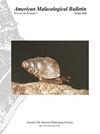软体动物名字中的性别代表:差异与遗产
IF 0.4
4区 生物学
Q4 MARINE & FRESHWATER BIOLOGY
引用次数: 1
摘要
摘要:指人的科学名称被称为同名,由物种作者选择,具有尊敬性、意义性或象征性。本文分析了全球8个地区4915种软体动物的雌性和雄性人名。其中,雌性占10.6% (n = 65),雄性占89.4% (n = 550)。腹足类中,雌性名占同名种名的3.4-18.9%;男性名占81.1% ~ 96.6%。在双壳类中,8个地区中有5个地区的种名中没有雌性名。头足类和石壳类包括22种雄性同名动物,无雌性同名动物。科学家和博物学家被认为是29.2%的女性和64.6%的男性名字的来源。63.1%的女性名字和4.6%的男性名字来源于名字。93.8%的男性姓氏和35.4%的女性姓氏来源于姓氏。以女性名字命名最多的人(n = 4)是20世纪美国动物学家a·米拉·基恩;一个人的最多的名字(n = 6)是两位19世纪的英国博物学家,托马斯·纳托尔和罗伯特·斯温霍。软体动物名字中的性别不对称可能反映了直到20世纪末女性参与软体动物学、分类学和系统学的障碍。认识到这种不平等应该为有关女性在科学名称中的代表性的讨论提供信息,并为理解名称的历史和它们所纪念的人提供背景。本文章由计算机程序翻译,如有差异,请以英文原文为准。
Gender Representation in Molluscan Eponyms: Disparities and Legacy
Abstract: Scientific names that refer to people are called eponyms and are chosen by species authors as honorific, meaningful, or symbolic. Herein, female and male personal eponyms were analyzed from a dataset of 4,915 molluscan species within eight regions worldwide. Eponyms were 12.5% of all species names, within which 10.6% (n = 65) were female and 89.4% (n = 550) were male. Among gastropods, female eponyms accounted for 3.4–18.9% of eponymous species names; male eponyms were 81.1–96.6%. Among bivalves, species names within five of eight regions included no female eponyms. Cephalopod and chiton species included 22 male eponyms and no female eponyms. Scientists and naturalists were honored as the source of 29.2% of female eponyms and 64.6% of male eponyms. First names were the source of 63.1% of female eponyms and 4.6% of male eponyms. Last names were the source of 93.8% of male eponyms and 35.4% of female eponyms. The most eponyms for a woman (n = 4) honor 20th century American malacologist, A. Myra Keen; the most eponyms for a man (n = 6) honor two 19th century English naturalists, Thomas Nuttall and Robert Swinhoe. Gender asymmetry in molluscan eponyms likely reflects barriers to women's participation in malacology, taxonomy, and systematics until the late 20th century. Recognition of this inequity should inform discussions about female representation in scientific names and provide context for understanding the history of eponyms and the people they honor.
求助全文
通过发布文献求助,成功后即可免费获取论文全文。
去求助
来源期刊
CiteScore
1.00
自引率
40.00%
发文量
1
审稿时长
>12 weeks
期刊介绍:
The American Malacological Bulletin serves as an outlet for reporting notable contributions in malacological research. Manuscripts concerning any aspect of original, unpublished research,important short reports, and detailed reviews dealing with molluscs will be considered for publication. Recent issues have included AMS symposia, independent papers, research notes,and book reviews. All published research articles in this journal have undergone rigorous peer review, based on initial editor screening and anonymous reviewing by independent expertreferees. AMS symposium papers have undergone peer review by symposium organizer, symposium participants, and independent referees.

 求助内容:
求助内容: 应助结果提醒方式:
应助结果提醒方式:


